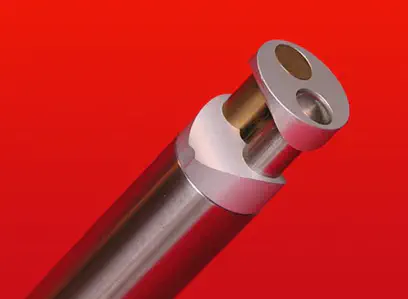Windshields for PU probes
Numerical simulation of a PU probe (pressure-particle velocity sensor) in the presence of an underlying flow
 Pressure-particle velocity sensor designed by Microflown Technologies
Pressure-particle velocity sensor designed by Microflown TechnologiesThe industrial partner Microflown Technologies designs and produces PU probes, which are able to measure particle velocity and acoustic pressure fields simultaneously, are sensitive to the effect of wind, since they are based on thermal transducers and hence highly dependent on the variations of thermal flow velocity. Objectives of this research project are the mathematical modelling and numerical simulation of thermo-acoustic coupled Systems (involving PU probes, the compressible fluid in the presence of flow, and the multilayer windscreen). The numerical results will play a key role in the design of novel windscreens to mitigate the flow effects on the measures of acoustic probes.
 Figure 1: Scattering field of a plane wave impiging the PU device with a porous wind shield.
Figure 1: Scattering field of a plane wave impiging the PU device with a porous wind shield.
The present project is part of the European project ROMSOC (an MSCA European Industrial Doctorate programme). More
precisely, since the wind-shield enclosures generate complex acoustics fields inside (see [1] for more details), three
different approaches will be analysed by solving numerically the following coupled problems:
(A) Modelling and numerical simulation of the three dimensional coupled acoustic
behaviour of a multilayer system consisting in the combination of waterproof fabrics with
open porous foams. Novel effective structural-acoustic models will be developed for the
structural elements and the sponge layer (see [2])
(B) Modelling and numerical
simulation of the three dimensional coupled thermal-acoustic behaviour of a multilayer
structure composed of metallic micro-perforated screens surrounding the USP probe. The
characterization of the mechanical impedance of this protected screen will be computed
in the presence of flow.
(C) Modelling and numerical simulation of the three dimensional
coupled thermal-acoustic behaviour of micro-machined wind-shields consisting in a twolayer
structure (a nano-perforated thin foil glued to a silicon substrate where the device wires
are lying). The turbulence flow around the micro-machined transducer will be characterized.
In addition, since the shape of the structure around the sensor can improve the behaviour
under flow noise and weak signals, different shapes around
the sensor will be tested and compared in different SNR scenarios.
References
[1] Ashwin S. NayakMathematical Modelling and Numerical Simulation of Coupled Acoustic Multi-layer Systems for Enabilng Particle Velocity Measurements in the Presence of Airflow
Phd thesis in mathematical modelling and numerical simulation in engineering and applied science, Universidade da Coruña, 2021. Advisors: D. Fernández Comesaña (Microflown Technologies), A. Prieto.
[2] A. Nayak, A. Prieto, D. Fernández-Comesaña
Model coupling for acoustic sensors in layered media
14th World Congress on Computational Mechanics (WCCM) ECCOMAS Congress 2020,11–15 January 2021.